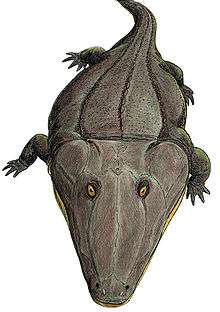Bukobay Svita
The Bukobay Svita (also anglicized as "Bukobay Formation") is a Middle Triassic geological unit in Russia. It is composed primarily of red or grey lacustrine sediments, reconstructing a humid and marshy depositional environment. Bukobay is the youngest section of a Triassic terrestrial succession exposed south of the Ural Mountains. It is equivalent to a biostratigraphic unit, the Bukobay Gorizont, which is also called the "Bukobay Horizon" or "Mastodonsaurus" fauna). Notable components of the Bukobay fauna include "Mastodonsaurus" torvus (a giant capitosaur amphibian), Elephantosaurus jachimovitschi (a large dicynodont), and Chalishevia cothurnata (the youngest known erythrosuchid). The flora is also diverse, including Equisetites arenaceus (a species of giant horsetails) and Ladinian-age palynomorphs.[1][2]
| Bukobay Svita Stratigraphic range: Ladinian | |
|---|---|
 "Mastodonsaurus" torvus, an index fossil of the Bukobay Svita / Gorizont | |
| Type | Stratigraphic Formation |
| Overlies | Donguz Svita |
| Area | Orenburg Oblast |
| Lithology | |
| Primary | clay, siltstone |
| Other | sandstone |
References
- Tverdokhlebov, Valentin P.; Tverdokhlebova, Galina I.; Surkov, Mikhail V.; Benton, Michael J. (2003). "Tetrapod localities from the Triassic of the SE of European Russia". Earth-Science Reviews. 60 (1): 1–66. doi:10.1016/S0012-8252(02)00076-4. ISSN 0012-8252.
- Tverdokhlebov, V. P.; Sennikov, A. G.; Novikov, I. V.; Ilyina, N. V. (May 2020). "The Youngest Triassic Land Vertebrate Assemblage of Russia: Composition and Dating". Paleontological Journal. 54 (3): 297–310. doi:10.1134/S0031030120030156. ISSN 1555-6174.